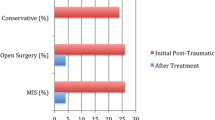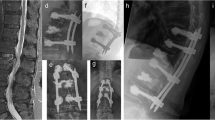Abstract
We retrospectively reviewed 31 neurologically intact patients with burst L1 fractures. We obtained a follow-up clinical evaluation after a mean of 43 (14–80) months from 26 patients—11 treated surgically and 15 managed non-surgically. Patients were assessed with regard to pain, employment status, recreational activities and overall satisfaction. At final follow-up of 15 patients managed non-surgically, six had little or no pain; 12 had returned to work with six declaring little or no restrictions, and eight had returned to the same level of recreational activity as prior to injury with seven declaring little or no restrictions. Of 11 patients treated surgically, four had little or no pain; seven had returned to work with three declaring little or no restrictions, three had returned to the same level of recreational activity as prior to injury and four declared little or no restrictions. There was no correlation found between vertebral collapse, kyphosis, retropulsion and clinical outcome. Patients who had non-operative management reported a good functional outcome. However, patients who required surgical stabilisation due to different fracture characteristics reported a poorer functional outcome.
Résumé
Nous avons examiné rétrospectivement 31 malades avec une burst fracture de L1, sans trouble neurologique. Nous avons obtenu une évaluation clinique après un suivi moyen de 43 mois (14–80) pour 26 malades, 11 traités chirurgicalement et 15 non-chirurgicalement. Les malades ont été répartis selon la douleur, le statut de l’emploi, les activités de loisirs et la satisfaction globale. Au dernier examen des 15 malades traités non-chirurgicalement, six avaient peu ou aucune douleur; 12 avaient repris leur travail avec six déclarant peu ou aucune restriction et huit étaient revenus, pour les activités de loisirs, au même niveau qu’avant la fracture avec sept déclarant peu ou aucune restriction. Parmi les 11 malades traités chirurgicalement, quatre avaient peu ou aucune douleur; sept avaient repris le travail avec trois déclarant peu ou aucune restriction, trois étaient revenus au même niveau d’activité de loisirs et quatre déclaraient peu ou aucune restriction. Aucune corrélation n’a été trouvé entre le collapsus vertébral, la cyphose, la rétropulsion et le résultat clinique. Les malades qui avaient été traité non-chirurgicalement ont rapporté un bon résultat fonctionnel. Les malades qui ont nécessité une stabilisation chirurgicale à cause des caractéristiques de la fracture ont rapporté un résultat fonctionnel moins bon.
Similar content being viewed by others
References
Chow GH, Nelson BJ, Gebhard JS, Brugman JL, Brown CW, Donaldson DH (1996) Functional outcome of thoracolumbar burst fractures managed with hyperextension casting or bracing and early mobilisation. Spine 21:2170–2175
Denis F (1983) The three column spine and its significance in the classification of acute thoracolumbar spinal injuries. Spine 8:817–831
Denis F, Armstrong GWD, Searls K, Matta L (1984) Acute thoracolumbar burst fractures in the absence of neurological deficit: a comparison between operative and nonoperative treatment. Clin Orthop 189:142–149
Leferink VJ, Keizer HJ, Oosterhuis JK, van der Sluis CK, ten Duis HJ (2003) Functional outcome in patients with thoracolumbar burst fractures treated by dorsal instrumentation and transpedicular cancellous bone grafting. Eur Spine J 12:261–267
Shen W, Shen Y (1999) Nonsurgical treatment of three-column thoracolumbar junction burst fractures without neurological deficit. Spine 24:412–415
Shen W, Liu T, Shen Y (2001) Nonoperative treatment versus posterior fixation for thoracolumbar junction burst fractures without neurologic deficit. Spine 26:1038–1045
Tropiano P, Huang RC, Louis CA, Poitout DG, Louis RP (2003) Functional and radiographic outcome of thoracolumbar and lumbar burst fractures managed by closed orthopaedic reduction and casting. Spine 28:2459–2465
Wood K, Butterman G, Mehbod A, Garvey T, Jhanjee R, Sechriest V (2003) Operative compared with nonoperative treatment of a thoracolumbar burst fracture without neurological deficit. A prospective, randomised study. J Bone Joint Surg Am 85:773–781
Author information
Authors and Affiliations
Corresponding author
Rights and permissions
About this article
Cite this article
Butler, J.S., Walsh, A. & O’Byrne, J. Functional outcome of burst fractures of the first lumbar vertebra managed surgically and conservatively. International Orthopaedics (SICOT) 29, 51–54 (2005). https://doi.org/10.1007/s00264-004-0602-x
Received:
Accepted:
Published:
Issue Date:
DOI: https://doi.org/10.1007/s00264-004-0602-x




